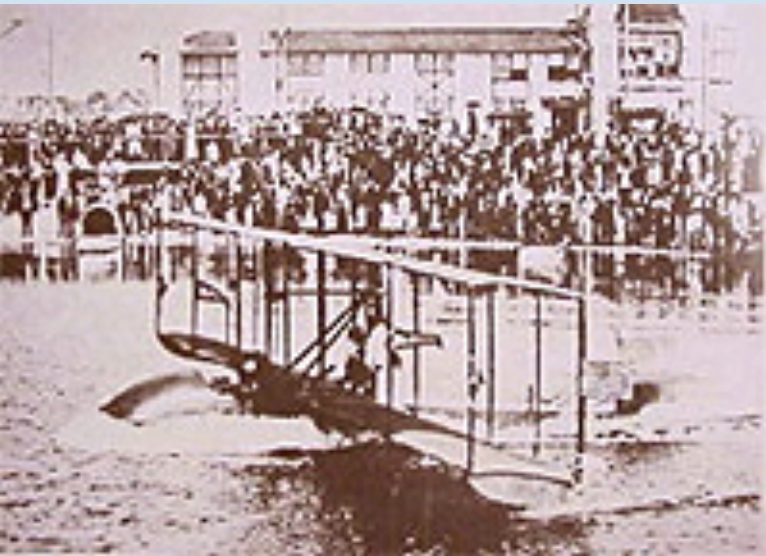On January 1, 1914, the dawn of commercial aviation was heralded by a short but significant flight from St. Petersburg to Tampa, Florida. This pioneering journey, undertaken by pilot Tony Jannus in a Benoist XIV biplane, marked the inception of the world’s first scheduled airline service, the St. Petersburg-Tampa Airboat Line. The flight revolutionized transportation and laid the foundation for the global commercial aviation industry.
Historical Context

The early 20th century was a period of rapid advancements in aviation, spurred by the success of the Wright brothers’ first powered flight in 1903. Aviation pioneers were experimenting with new aircraft designs and attempting longer, more ambitious flights. Amid this backdrop, Thomas Benoist, a visionary aircraft manufacturer, was pushing the boundaries of aviation technology with his Benoist Aircraft Company.
The idea of using airplanes for commercial purposes was revolutionary. Most early flights were demonstrations, stunts, or military applications. The notion of a scheduled passenger service was unheard of until Percival Elliott Fansler, a Florida-based entrepreneur, conceived the idea of a regular air service between St. Petersburg and Tampa. Fansler saw the potential for aviation to transform transportation and reduce travel time significantly between the two cities, which were separated by the expansive Tampa Bay.
The St. Petersburg-Tampa Airboat Line
Fansler’s vision quickly gained traction. He partnered with Thomas Benoist, whose aircraft were known for their reliability and performance. The Benoist XIV, a biplane capable of carrying a pilot and one passenger, was selected for the service. The aircraft was equipped with pontoons, allowing it to take off and land on water, making it suitable for the route across Tampa Bay.
The St. Petersburg-Tampa Airboat Line was officially established, and advertisements for the new service promised a dramatic reduction in travel time—from a two-hour steamship journey or a grueling 12-hour trip by train and car to a mere 23-minute flight.
The Historic Flight
On the morning of January 1, 1914, a crowd of over 3,000 people gathered at the St. Petersburg waterfront to witness the historic event. Tony Jannus, a skilled aviator known for his daring flights and aerial exhibitions, was the pilot for the inaugural flight. The first passenger was Abram C. Pheil, the former mayor of St. Petersburg, who won the seat through an auction with a bid of $400, a significant sum at the time.
The Benoist XIV biplane, with its open cockpit and exposed engine, taxied into the waters of the Municipal Pier, now known as the St. Petersburg Pier. At precisely 10:00 AM, the aircraft lifted off, climbing to an altitude of 50 feet and heading towards Tampa. The flight across Tampa Bay was smooth, and 23 minutes later, the plane landed near the entrance of the Hillsborough River in Tampa, where another large crowd awaited their arrival.
The Impact of the Flight
The successful flight demonstrated the feasibility of commercial air travel and the reliability of aircraft for passenger service. The Benoist XIV, despite its rudimentary design by modern standards, was a robust and capable machine that proved essential in the early days of aviation.
The St. Petersburg-Tampa Airboat Line continued to operate for nearly four months, making twice-daily flights between the two cities. The service carried a total of 1,205 passengers, with an impeccable safety record and only a few minor incidents. This operation provided invaluable data and experience that would influence the design and operation of future commercial flights.
The introduction of commercial air service had a profound impact on the communities of St. Petersburg and Tampa. The flights shortened travel time between the cities, facilitating business and social interactions. The air service also attracted national and international attention, positioning St. Petersburg and Tampa as pioneers in the emerging field of commercial aviation.
Moreover, the success of the St. Petersburg-Tampa Airboat Line demonstrated the potential of aviation as a viable industry. It encouraged further investments in aviation infrastructure, including the development of more advanced aircraft, the establishment of airports, and the creation of regulatory frameworks to ensure safety and reliability in air travel.
Legacy and Commemoration
The legacy of the first commercial flight is commemorated in various ways. In St. Petersburg, the Pier has a monument dedicated to Tony Jannus and the historic flight. The annual Tony Jannus Distinguished Aviation Society awards recognize individuals who have made significant contributions to commercial aviation, perpetuating the pioneering spirit of Jannus and the early aviators.
The original Benoist XIV aircraft is long gone, but a replica can be seen at the St. Petersburg Museum of History. This exhibit serves as a tangible connection to the pioneering days of aviation and a reminder of the bold vision that launched the commercial aviation industry.
The first commercial flight from St. Petersburg to Tampa marked the beginning of a new era in transportation and laid the groundwork for the global aviation industry. The bold vision and pioneering spirit of early aviators like Tony Jannus and the support of visionary entrepreneurs like Percival Elliott Fansler transformed the dream of commercial aviation into reality.
Albert Whitted Airport continues to honor its legacy through preservation efforts and community engagement. As we celebrate the milestones of aviation history, the story of the first commercial flight serves as a reminder of the transformative power of innovation and the enduring impact of those who dare to dream.
By preserving and celebrating this history, we ensure that the pioneering spirit of early aviators continues to inspire future generations. The journey that began with a 23-minute flight across Tampa Bay has grown into an industry that connects the world, demonstrating the far-reaching impact of a single, bold vision.